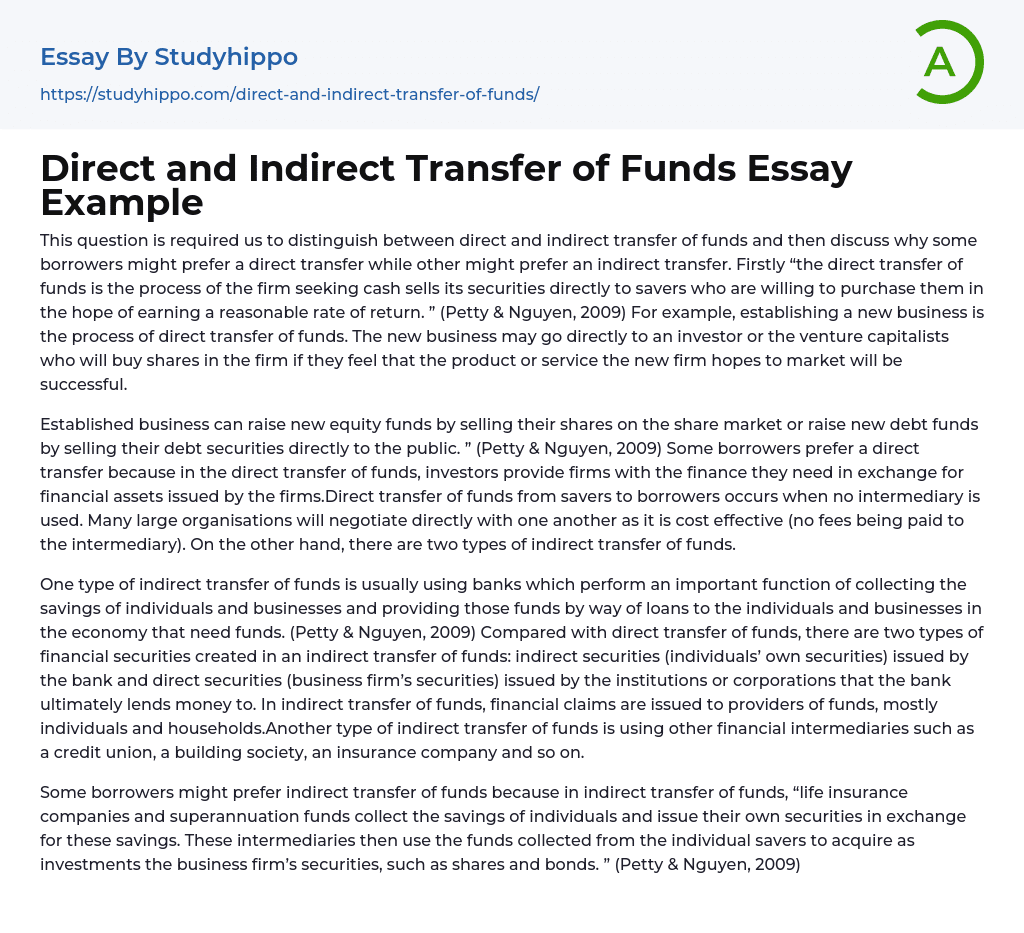This question is required us to distinguish between direct and indirect transfer of funds and then discuss why some borrowers might prefer a direct transfer while other might prefer an indirect transfer. Firstly “the direct transfer of funds is the process of the firm seeking cash sells its securities directly to savers who are willing to purchase them in the hope of earning a reasonable rate of return. ” (Petty & Nguyen, 2009) For example, establishing a new business is the process of direct transfer of funds. The new business may go directly to an investor or the venture capitalists who will buy shares in the firm if they feel that the product or service the new firm hopes to market will be successful.
Established business can raise new equity funds by selling their shares on the share market or rai
...se new debt funds by selling their debt securities directly to the public. ” (Petty & Nguyen, 2009) Some borrowers prefer a direct transfer because in the direct transfer of funds, investors provide firms with the finance they need in exchange for financial assets issued by the firms.Direct transfer of funds from savers to borrowers occurs when no intermediary is used. Many large organisations will negotiate directly with one another as it is cost effective (no fees being paid to the intermediary). On the other hand, there are two types of indirect transfer of funds.
One type of indirect transfer of funds is usually using banks which perform an important function of collecting the savings of individuals and businesses and providing those funds by way of loans to the individuals and businesses in the econom
that need funds. (Petty & Nguyen, 2009) Compared with direct transfer of funds, there are two types of financial securities created in an indirect transfer of funds: indirect securities (individuals’ own securities) issued by the bank and direct securities (business firm’s securities) issued by the institutions or corporations that the bank ultimately lends money to. In indirect transfer of funds, financial claims are issued to providers of funds, mostly individuals and households.Another type of indirect transfer of funds is using other financial intermediaries such as a credit union, a building society, an insurance company and so on.
Some borrowers might prefer indirect transfer of funds because in indirect transfer of funds, “life insurance companies and superannuation funds collect the savings of individuals and issue their own securities in exchange for these savings. These intermediaries then use the funds collected from the individual savers to acquire as investments the business firm’s securities, such as shares and bonds. ” (Petty & Nguyen, 2009)
- Commercial Bank essays
- Debit Card essays
- Deposit Account essays
- Subprime Lending essays
- Investing essays
- Asset essays
- Depreciation essays
- Discounted Cash Flow essays
- Foreign Direct Investment essays
- Funds essays
- Internal Rate Of Return essays
- Revenue essays
- Day Trading essays
- Futures Trading essays
- Capital market essays
- Million essays
- Payment essays
- Rate Of Return essays
- Funding essays
- Hedge Fund essays
- Bank essays
- Banking essays
- Corporate Finance essays
- Credit Card essays
- Currency essays
- Debt essays
- Donation essays
- Enron Scandal essays
- Equity essays
- Financial Accounting essays
- Financial Crisis essays
- Financial News essays
- Financial Ratios essays
- Financial Services essays
- Forecasting essays
- Foreign Exchange Market essays
- Free Market essays
- Gold essays
- Investment essays
- Legacy essays
- Loan essays
- Market Segmentation essays
- Money essays
- Personal finance essays
- Purchasing essays
- Retirement essays
- Shareholder essays
- Stock Market essays
- Supply And Demand essays
- Venture Capital essays




